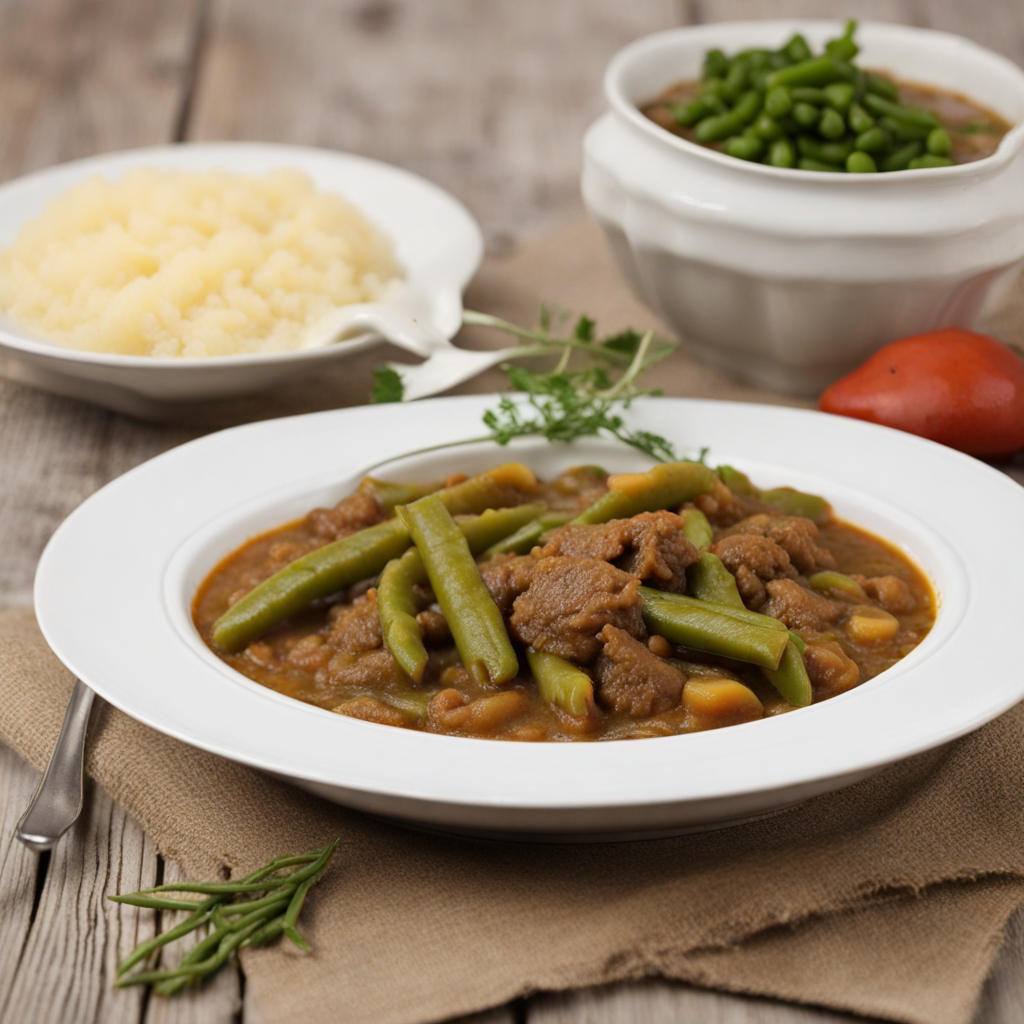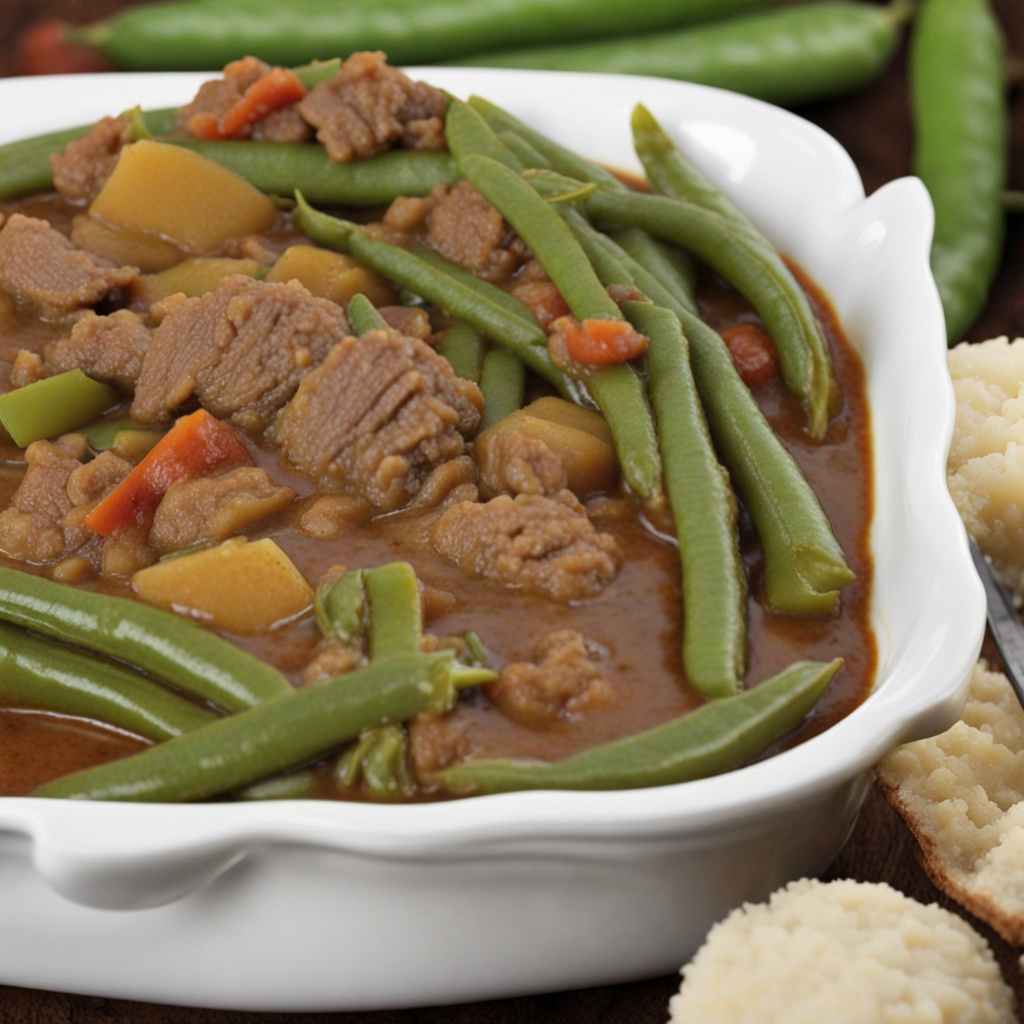Green Bean Bredie
Green Bean Bredie is a delightful South African dish that showcases the vibrant flavors of fresh green beans, often combined with tender meat, typically lamb or beef. This hearty stew is slow-cooked to perfection, allowing the ingredients to meld together harmoniously. The green beans maintain their vibrant color and crisp texture, providing a fresh contrast to the rich, savory broth that is infused with aromatic spices like garlic, ginger, and curry powder. The result is a comforting dish that is both nourishing and satisfying, ideal for sharing with family and friends. Traditionally, this bredie is prepared in a pot, where the meat is first browned and then simmered with onions and tomatoes. The addition of fresh herbs like thyme and bay leaves enhances the flavor profile, giving it an earthy depth. As the broth thickens, the green beans are added towards the end of the cooking process to ensure they retain their bright flavor and crunch. Served alongside fluffy rice or soft, crusty bread, Green Bean Bredie is a dish that embodies the spirit of South African cuisine, celebrating the use of fresh, local ingredients. What sets Green Bean Bredie apart is its ability to balance the richness of the meat with the freshness of the vegetables, creating a symphony of flavors in every bite. The stew is often enjoyed on special occasions or family gatherings, where it brings people together around a shared meal. This dish not only offers a taste of South African culinary traditions but also invites adventurous eaters to explore the unique combinations of spices and textures that define this beloved comfort food.
How It Became This Dish
The History of Green Bean Bredie: A Culinary Journey from South Africa Green Bean Bredie is a beloved dish from South Africa, steeped in rich history and cultural significance. This hearty stew, primarily featuring green beans, lamb, and a medley of spices, exemplifies the diverse influences that have shaped South African cuisine over centuries. Its origins, cultural importance, and evolution reflect the broader narrative of a nation characterized by its complex tapestry of cultures, peoples, and histories. #### Origins: A Culinary Crossroads The roots of Green Bean Bredie can be traced back to the Cape Malay community, a group of people of mixed descent, including indigenous Khoisan, enslaved individuals from Southeast Asia, and European settlers. The term "bredie" itself is derived from the Afrikaans word for stew, which indicates its heavy influences from both Dutch and Malay cooking traditions. The Cape Malay community, in particular, played a pivotal role in defining the dish. Bredies were traditionally made with whatever ingredients were available, making them a flexible and resourceful choice in a time when food scarcity was common. The spices used in Green Bean Bredie reflect the community's heritage: fragrant cardamom, cumin, coriander, and cinnamon are often included, highlighting the dish's Asian influences, while the use of lamb or mutton shines a light on European cooking practices. #### Cultural Significance Green Bean Bredie is more than just a meal; it is a cultural emblem of South Africa's diverse population. In many ways, it represents the blending of various culinary traditions, showcasing the country’s multicultural identity. The dish is often enjoyed during family gatherings, celebrations, and festivals, reinforcing social bonds and community ties. For the Cape Malay community, the preparation of Green Bean Bredie is often a communal affair, where family members come together to cook and share stories. This practice is reminiscent of historical cooking traditions where food preparation was a communal activity, fostering a sense of belonging and identity. The warm, inviting aroma of the stew often wafts through homes, evoking nostalgia and memories of shared meals. Moreover, Green Bean Bredie is often associated with comfort and sustenance. In a country that has faced social and economic challenges, the dish remains a symbol of resilience and adaptability. It is a testament to the ability of communities to create nourishing meals from simple ingredients, showcasing the resourcefulness of South African cooks. #### Development Over Time As South Africa underwent significant social and political changes, so too did its culinary landscape. The introduction of new ingredients and cooking techniques throughout the centuries has contributed to the evolution of Green Bean Bredie. With the arrival of British settlers in the 19th century, new vegetables and flavor profiles were introduced, enriching the traditional recipe. In contemporary South Africa, Green Bean Bredie has been embraced by a broader audience, transcending its original cultural boundaries. While it remains a staple in Cape Malay households, it is now found on menus in fine dining establishments and casual eateries alike. Chefs have begun to experiment with the recipe, incorporating local produce and modern cooking techniques, thus expanding its appeal. The globalization of food culture has also played a significant role in the dish's evolution. With the rise of social media and food blogging, Green Bean Bredie has garnered attention beyond South Africa’s borders. Home cooks and chefs worldwide are discovering the dish, often adding their own unique twists while respecting its traditional roots. #### A Recipe for Connection At its core, Green Bean Bredie is a celebration of connection—between families, communities, and cultures. The dish serves as a culinary reminder of South Africa's complex history, where diverse groups of people have contributed to the nation's identity. The incorporation of seasonal vegetables, particularly fresh green beans, speaks to the importance of local agriculture and sustainability. Traditionally, the preparation of Green Bean Bredie involves slow cooking, allowing the flavors to meld and deepen. The green beans are simmered with tender cuts of lamb, often accompanied by potatoes or other seasonal vegetables, creating a hearty meal. The use of spices adds layers of flavor, making each bite a delightful experience. As the dish continues to evolve, it remains rooted in its origins, reflecting the adaptability and creativity of South African cooks. In a world where food often acts as a bridge between cultures, Green Bean Bredie stands as a delicious testament to the power of culinary heritage. #### Conclusion: The Legacy of Green Bean Bredie Green Bean Bredie is more than just a dish; it is a culinary narrative that captures the essence of South Africa’s rich history. From its humble beginnings in the Cape Malay community to its contemporary interpretations, the stew is a reflection of the nation's diverse cultural landscape. As South Africans continue to share this dish with family and friends, they also pass down stories of resilience, adaptability, and the importance of community. In a world that often feels fragmented, Green Bean Bredie serves as a reminder of the connections that food can create. It invites diners to appreciate the flavors and stories of those who came before, celebrating the shared experiences that unite us all. Whether enjoyed in a traditional setting or reimagined in a modern kitchen, Green Bean Bredie will continue to be a cherished dish, resonating with the heart and soul of South African culinary tradition for generations to come.
You may like
Discover local flavors from South Africa







